The lesion-mimic mutant cpr22 shows alterations in abscisic acid signaling and abscisic acid insensitivity in a salicylic acid-dependent manner
- PMID: 20164209
- PMCID: PMC2850030
- DOI: 10.1104/pp.109.152603
The lesion-mimic mutant cpr22 shows alterations in abscisic acid signaling and abscisic acid insensitivity in a salicylic acid-dependent manner
Abstract
A number of Arabidopsis (Arabidopsis thaliana) lesion-mimic mutants exhibit alterations in both abiotic stress responses and pathogen resistance. One of these mutants, constitutive expresser of PR genes22 (cpr22), which has a mutation in two cyclic nucleotide-gated ion channels, is a typical lesion-mimic mutant exhibiting elevated levels of salicylic acid (SA), spontaneous cell death, constitutive expression of defense-related genes, and enhanced resistance to various pathogens; the majority of its phenotypes are SA dependent. These defense responses in cpr22 are suppressed under high-humidity conditions and enhanced by low humidity. After shifting plants from high to low humidity, the cpr22 mutant, but not the wild type, showed a rapid increase in SA levels followed by an increase in abscisic acid (ABA) levels. Concomitantly, genes for ABA metabolism were up-regulated in the mutant. The expression of a subset of ABA-inducible genes, such as RD29A and KIN1/2, was down-regulated, but that of other genes, like ABI1 and HAB1, was up-regulated in cpr22 after the humidity shift. cpr22 showed reduced responsiveness to ABA not only in abiotic stress responses but also in germination and stomatal closure. Double mutant analysis with nahG plants that degrade SA indicated that these alterations in ABA signaling were attributable to elevated SA levels. Furthermore, cpr22 displayed suppressed drought responses by long-term drought stress. Taken together, these results suggest an effect of SA on ABA signaling/abiotic stress responses during the activation of defense responses in cpr22.
Figures
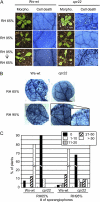
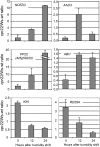
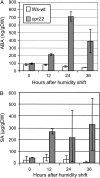
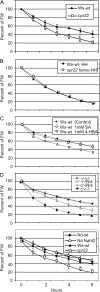

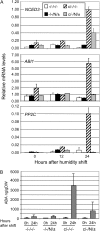
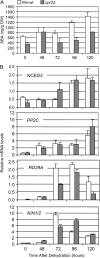
Similar articles
-
Environmentally sensitive, SA-dependent defense responses in the cpr22 mutant of Arabidopsis.Plant J. 2001 May;26(4):447-59. doi: 10.1046/j.1365-313x.2001.2641039.x. Plant J. 2001. PMID: 11439131
-
SA-ABA antagonism in defense responses.Plant Signal Behav. 2010 Oct;5(10):1231-3. doi: 10.4161/psb.5.10.12836. Epub 2010 Oct 1. Plant Signal Behav. 2010. PMID: 20861686 Free PMC article.
-
The chimeric Arabidopsis CYCLIC NUCLEOTIDE-GATED ION CHANNEL11/12 activates multiple pathogen resistance responses.Plant Cell. 2006 Mar;18(3):747-63. doi: 10.1105/tpc.105.038786. Epub 2006 Feb 3. Plant Cell. 2006. PMID: 16461580 Free PMC article.
-
MYB96-mediated abscisic acid signals induce pathogen resistance response by promoting salicylic acid biosynthesis in Arabidopsis.New Phytol. 2010 Apr;186(2):471-83. doi: 10.1111/j.1469-8137.2010.03183.x. Epub 2010 Feb 8. New Phytol. 2010. PMID: 20149112
-
Disruption of abscisic acid signaling constitutively activates Arabidopsis resistance to the necrotrophic fungus Plectosphaerella cucumerina.Plant Physiol. 2012 Dec;160(4):2109-24. doi: 10.1104/pp.112.200154. Epub 2012 Oct 4. Plant Physiol. 2012. PMID: 23037505 Free PMC article.
Cited by
-
The Arabidopsis PLAT domain protein1 promotes abiotic stress tolerance and growth in tobacco.Transgenic Res. 2015 Aug;24(4):651-63. doi: 10.1007/s11248-015-9868-6. Epub 2015 Mar 11. Transgenic Res. 2015. PMID: 25757741
-
Identification of a Spotted Leaf Sheath Gene Involved in Early Senescence and Defense Response in Rice.Front Plant Sci. 2018 Sep 5;9:1274. doi: 10.3389/fpls.2018.01274. eCollection 2018. Front Plant Sci. 2018. PMID: 30233619 Free PMC article.
-
Mutation of SPOTTED LEAF3 (SPL3) impairs abscisic acid-responsive signalling and delays leaf senescence in rice.J Exp Bot. 2015 Dec;66(22):7045-59. doi: 10.1093/jxb/erv401. Epub 2015 Aug 14. J Exp Bot. 2015. PMID: 26276867 Free PMC article.
-
The Arabidopsis cyclic nucleotide-gated ion channels AtCNGC2 and AtCNGC4 work in the same signaling pathway to regulate pathogen defense and floral transition.Plant Physiol. 2013 Oct;163(2):611-24. doi: 10.1104/pp.113.225680. Epub 2013 Sep 11. Plant Physiol. 2013. PMID: 24027242 Free PMC article.
-
Calmodulin binding to Arabidopsis cyclic nucleotide gated ion channels.Plant Signal Behav. 2010 Sep;5(9):1147-9. doi: 10.4161/psb.5.9.12676. Epub 2010 Sep 1. Plant Signal Behav. 2010. PMID: 21150265 Free PMC article.
References
-
- Baxter J, Moeder W, Urquhart W, Shahinas D, Chin K, Christendat D, Kang HG, Angelova M, Kato N, Yoshioka K. (2008) Identification of a functionally essential amino acid for Arabidopsis cyclic nucleotide gated ion channels using the chimeric AtCNGC11/12 gene. Plant J 56: 457–469 - PubMed
-
- Bent AF, Mackey D. (2007) Elicitors, effectors, and R genes: the new paradigm and a lifetime supply of questions. Annu Rev Phytopathol 45: 399–436 - PubMed
Publication types
MeSH terms
Substances
Grants and funding
LinkOut - more resources
Full Text Sources
Molecular Biology Databases
Research Materials

